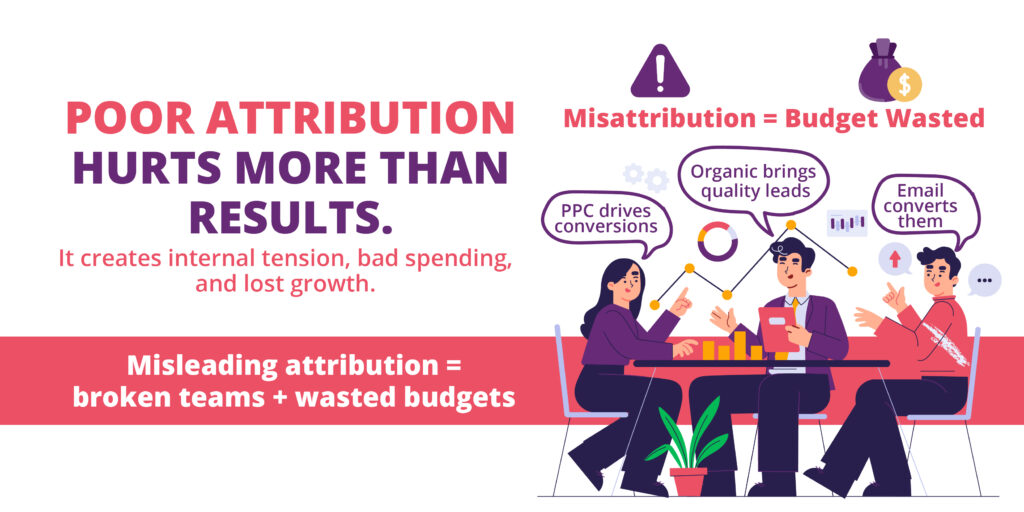Blog
Marketing leaders are under constant pressure to prove ROI and justify budget allocations, yet many still struggle to track marketing effectiveness accurately.
When it’s time to evaluate performance and allocate the next quarter’s budget, you realize you don’t have a clear answer to the most critical questions:
If you’re relying on flawed attribution models, these decisions are based on misleading data.

This blog will dive into:
Attribution isn’t just about tracking conversions—it influences how teams work together, how budgets are allocated, and how executives make decisions.
Marketing teams rely on attribution to measure success, but when attribution models fail, frustration builds:
When one team’s contribution is overlooked, it leads to:
Example:
A B2B company relied on last-click attribution, which credited PPC for most conversions. However, analysis showed that 75% of those leads first engaged through organic search and email nurturing.
Because the SEO and email teams weren’t getting recognized, resources shifted to PPC, leading to fewer high-quality leads and a drop in overall revenue.
If attribution models overvalue or undervalue certain channels, companies waste budget on the wrong strategies.
Example:
A SaaS company allocated 60% of its budget to PPC, assuming it was their best-performing channel.
After implementing custom attribution, they discovered:
By reallocating their budget, they increased ROI by 40% in just three months.

Many businesses rely on built-in attribution models from Google Analytics, Facebook Ads, or their CRM. These models offer basic tracking but fail to reflect real customer behavior.
Attribution Model | How It Works | Why It Fails |
Last-Click Attribution | Assigns all credit to the final interaction. | Ignores everything that happened earlier in the customer journey. |
First-Click Attribution | Credits the first touchpoint. | Misses all later interactions that contributed to the sale. |
Linear Attribution | Distributes credit equally across all interactions. | Treats all touchpoints the same, even if some had a stronger impact. |
Time Decay Attribution | Gives more credit to interactions closer to conversion. | Undervalues long-term brand awareness efforts. |
The real problem? These models don’t reflect how customers actually make decisions—leading to misguided budget allocation and ineffective marketing strategies.
Example:
A tech company that relied on last-click attribution was overinvesting in Google Ads, believing it was the primary driver of sales.
After switching to a custom attribution model, they found:
Adjusting their budget accordingly resulted in a 50% increase in marketing efficiency.
Want a custom attribution strategy for your business?
Q: Why is last-click attribution flawed?
It ignores early and mid-funnel interactions, leading to misleading performance reports.
Q: How do I track offline marketing touchpoints?
Integrate CRM data, call tracking, QR codes, and sales team insights into your attribution model.
Q: How long does it take to implement a custom attribution model?
Most businesses see improvements in 3-6 months, but ongoing refinement is key.
Q: What industries benefit most from custom attribution?
B2B SaaS, eCommerce, financial services, and any business with multi-touch marketing.
Share:

Data that Moves Your Business

Stay ahead with expert insights on marketing analysis, data-driven strategies, and industry trends.

Revenue Growth Analyst
Data Unification Specialist,
previously at a leading
Ecommerce Giant
Discover our latest success stories
and see how innovative strategies
drive measurable results.
Gain clear insights into what’s
driving conversions and optimize
your marketing spend with ease.
Businesses that leverage automated marketing
attribution see a 20-30% improvement in ad
spend efficiency.